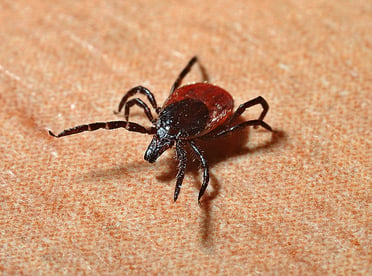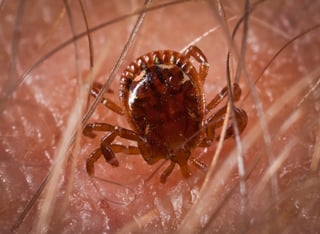Eliminate and Prevent Ticks in NJ and PA

What is a Tick?
Ticks are parasites that will attach to a host (animal or human) for days at a time to feed on their blood. There are several types of tick that can be found in the North Eastern United States. There are some variations between species and between developmental stages, but in general, ticks have 8 legs and can grow as large as 1/2 of an inch. While not all ticks feed on blood as adults, it is necessary for them to do so in order to reach the adult stage of their life cycle. They are most commonly found in forests and other areas of where the land is not maintained or manicured (though certain ticks can and will find their way into well cared for lawns). Almost all ticks in the New Jersey area are capable of spreading disease.
There are a number of ticks that commonly found in New Jersey as well as Bucks County and Montgomery County Pennsylvania which include:
Deer Tick:
Deer Ticks are the primary tick responsible for the transmission of Lyme disease.These ticks do not travel far from their questing areas and are usually encountered during recreational activities in the woods of in meadows.
American Dog Tick:
American Dog Ticks are the most frequently encountered tick and are the most likely tick to be found on both pets and humans. These ticks are very active and will travel from their questioning locations into manicured areas. These ticks will readily use humans as a host and are capable of transmitting Rocky Mountain spotted fever.
Brown Dog Tick:
Brown Dog Ticks are very specific to dogs and are rarely found on humans; although, this tick is a domestic species and is the only tick which will leave its host and infest the home. They are primarily found in cracks and crevices of the home. It is believed that the tick is usually brought into homes by dogs which have picked them up while visiting infested structures such as veterinarians, groomers, kennels, etc.
Lone Star Tick:
Lone Star Ticks are very aggressive ticks and will actively travel from their questing locations into manicured areas. Lone Star Ticks are commonly found on a wide variety of animals, including humans. These ticks are capable of transmitting Lyme disease, Rocky Mountain spotted fever and Tularemia.
Why do I have them?

You are most likely to encounter ticks when walking in an area that is naturally infested with ticks, like a forest or tall grass. While some ticks will venture out into even the best kept lawns, your chances of seeing ticks are increased if your property borders wooded areas, or if you walk in such areas frequently.
Why are we smarter?
Our knowledge of Tick biology allows us to create cutting-edge treatments to successfully reduce residential Tick problems. The Cooper methodology is based on scientific research, which is what sets us apart from the competition. While many companies focus on trying to treat ticks by providing large-scale turf applications, Cooper knows that Ticks live and breed in the un-manicured areas around your home!
When a lawn and turf company treats for ticks around your home, they will typically treat only the grass by applying pesticides to your manicured lawn. While this may occasionally eliminate an occasional tick that may have migrated, Cooper’s methodology is much more effective and uses much less pesticide.
How is Cooper’s methodology proven to reduce Ticks?
At Cooper, we believe it is unnecessary to treat the entire lawn since ticks don’t live in manicured lawns! Our methodology prevents ticks from entering into your yard by providing targeted applications in areas where ticks live and breed. Our method is to treat the un-manicured areas around your home - mulch, groundcover, leaf litter, and any other overgrown area. We will also treat the perimeter of your yard and 5 feet into the turf which will prevent Ticks from migrating into your yard. Not only is our treatment more effective, but it is also more environmentally conscious since our treatment uses less pesticide.
In the event that you find another pest control company offering Tick prevention services, we recommend that you ask them “how are you treating for Ticks?”, “will you treat the surrounding areas around my lawn or only the turf?", and “is it necessary to apply pesticides to my entire lawn?” At Cooper Pest Solutions, we guarantee Ticks will be 100% prevented and that you will be “wowed” by our service.
Smarter = Tick Prevention
Why should I be concerned with Ticks?
Ticks are known to transmit diseases, including Lyme Disease, Rocky Mountain spotted fever, and Tularemia. All of these diseases are quite serious, but can often be cleared up with timely medical attention. Even without the risk of disease, most ticks that are seen by humans are feeding on the blood of a human or a pet, making them very unwelcome.
How do I get rid of Ticks?

Since ticks will naturally occur in certain areas, there is not much that you can do to get rid of them on your own. However, they can be controlled with targeted applications of pesticides. One of Cooper's trained technicians can analyze your property and propose treatment that will best suit your needs.
What service options are available?
Cooper offers a Tick Prevention Service that reduces the likelihood of tick entry into the yard by specifically treating the areas throughout the property where ticks are likely to harbor and breed. A skilled technician will assess your needs based on your property and the surrounding environment and target treatment in the areas where ticks are already present. This treatment will ideally begin in April, but can be effective as long as it begins before the fall. The service includes four treatments (the first two in the first two months and the following two every other month) with a chemical that has been proven to be highly effective in the control of ticks.
How soon can you get here?
At Cooper Pest Solutions, our goal is to provide fast, convenient service, with the peace of mind that you are in good hands. We understand that pest problems can be stressful and overwhelming, so we strive to have one of our representatives meet with you the same day or very next day.
Is the treatment environmentally friendly?
There are many eco-friendly options available for tick control. In addition, all products used by Cooper Pest Solutions are EPA registered for pest control use. Our highly trained pest control professionals will follow all appropriate label requirements in an effort to keep pets and humans safe.
Call Cooper or fill out the form to learn more about our Tick Prevention Service.

